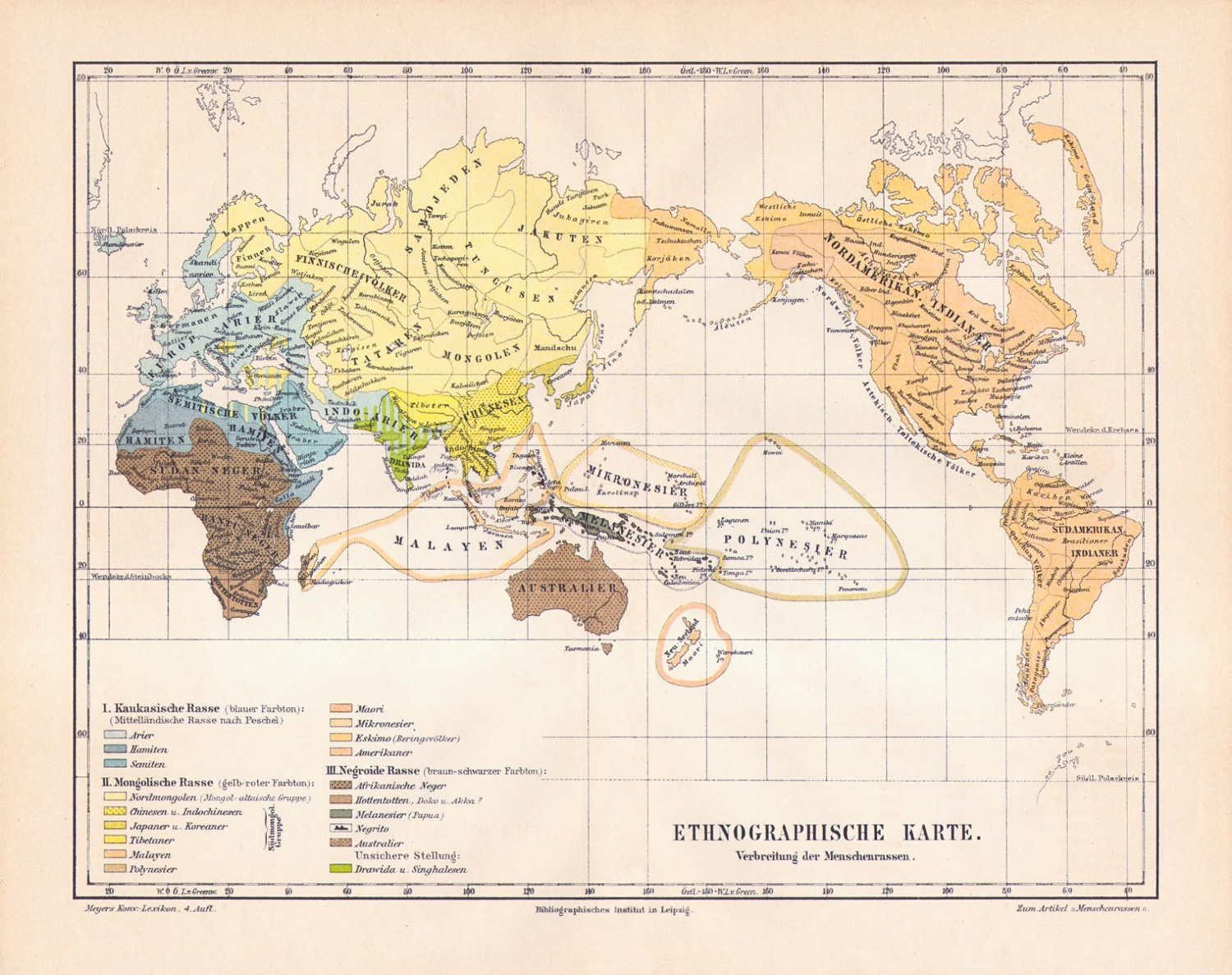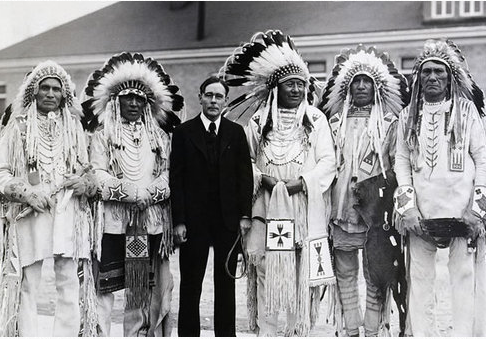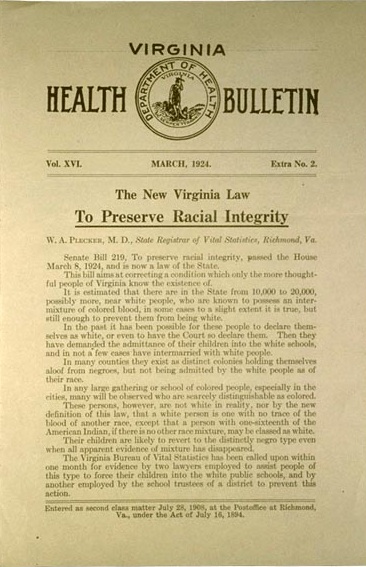|
One Drop Rule
The one-drop rule is a legal principle of racial classification that was prominent in the 20th-century United States. It asserted that any person with even one ancestor of Black people, black ancestry ("one drop" of "black blood")Davis, F. James. Frontlin"Who's black. One nation's definition" Retrieved 27 February 2015. is considered black (''Negro'' or ''colored'' in historical terms). It is an example of hypodescent, the automatic assignment of children of a mixed union between different socioeconomic or ethnic groups to the group with the lower status, regardless of proportion of ancestry in different groups.Conrad P. Kottak"What is hypodescent?", ''Human Diversity and "Race"'', Cultural Anthropology, Online Learning, McGraw Hill. Retrieved 21 April 2010. This concept became codified into the law of some U.S. states in the early 20th century. It was associated with the principle of "invisible blackness" that developed after the long history of racial interaction in the Southe ... [...More Info...] [...Related Items...] OR: [Wikipedia] [Google] [Baidu] |
Racial Classification
A race is a categorization of humans based on shared physical or social qualities into groups generally viewed as distinct within a given society. The term came into common usage during the 1500s, when it was used to refer to groups of various kinds, including those characterized by close kinship relations. By the 17th century, the term began to refer to physical (phenotypical) traits, and then later to national affiliations. Modern science regards race as a social construct, an Identity (social science), identity which is assigned based on rules made by society. While partly based on physical similarities within groups, race does not have an inherent physical or biological meaning. The concept of race is foundational to racism, the belief that humans can be divided based on the superiority of one race over another. Social conceptions and groupings of races have varied over time, often involving Folk taxonomy, folk taxonomies that define Wikt:essentiality, essential types of i ... [...More Info...] [...Related Items...] OR: [Wikipedia] [Google] [Baidu] |
Partus Sequitur Ventrem
''Partus sequitur ventrem'' (L. "That which is born follows the womb"; also ''partus'') was a legal doctrine passed in colonial Virginia in 1662 and other English crown colonies A Crown colony or royal colony was a colony administered by The Crown within the British Empire. There was usually a Governor, appointed by the British monarch on the advice of the UK Government, with or without the assistance of a local Council ... in British America, the Americas which defined the legal status of children born there; the doctrine mandated that all children would inherit the legal status of their mothers. As such, children of enslaved women would be born into slavery. The legal doctrine of ''partus sequitur ventrem'' was derived from Roman Civil law (legal system), civil law, specifically the portions concerning slavery and personal property (Personal property, chattels). The doctrine's most significant effect was placing into chattel slavery all children born to enslaved women. ''Pa ... [...More Info...] [...Related Items...] OR: [Wikipedia] [Google] [Baidu] |
Omaha People
The Omaha ( Omaha-Ponca: ''Umoⁿhoⁿ'') are a federally recognized Midwestern Native American tribe who reside on the Omaha Reservation in northeastern Nebraska and western Iowa, United States. There were 5,427 enrolled members as of 2012. The Omaha Reservation lies primarily in the southern part of Thurston County and northeastern Cuming County, Nebraska, but small parts extend into the northeast corner of Burt County and across the Missouri River into Monona County, Iowa. Its total land area is and the reservation population, including non-Native residents, was 4,526 in the 2020 census. Its largest community is Macy. The Omaha people migrated to the upper Missouri area and the Plains by the late 17th century from earlier locations in the Ohio River Valley. The Omaha speak a Siouan language of the Dhegihan branch, which is very similar to that spoken by the Ponca. The latter were part of the Omaha before splitting off into a separate tribe in the mid-18th century. They w ... [...More Info...] [...Related Items...] OR: [Wikipedia] [Google] [Baidu] |
Patrilineal
Patrilineality, also known as the male line, the spear side or agnatic kinship, is a common kinship system in which an individual's family membership derives from and is recorded through their father's lineage. It generally involves the inheritance of property, rights, names, or titles by persons related through male kin. This is sometimes distinguished from cognate kinship, through the mother's lineage, also called the spindle side or the distaff side. A patriline ("father line") is a person's father, and additional ancestors, as traced only through males. Traditionally and historically people would identify the person's ethnicity with the father's heritage and ignore the maternal ancestry in the ethnic factor. In the Bible In the Bible, family and tribal membership appears to be transmitted through the father. For example, a person is considered to be a priest or Levite, if his father is a priest or Levite, and the members of all the Twelve Tribes are called Israelites because ... [...More Info...] [...Related Items...] OR: [Wikipedia] [Google] [Baidu] |
Métis
The Métis ( ; Canadian ) are Indigenous peoples who inhabit Canada's three Prairie Provinces, as well as parts of British Columbia, the Northwest Territories, and the Northern United States. They have a shared history and culture which derives from specific mixed European (primarily French) and Indigenous ancestry which became a distinct culture through ethnogenesis by the mid-18th century, during the early years of the North American fur trade. In Canada, the Métis, with a population of 624,220 as of 2021, are one of three major groups of Indigenous peoples that were legally recognized in the Constitution Act of 1982, the other two groups being the First Nations and Inuit. Smaller communities who self-identify as Métis exist in Canada and the United States, such as the Little Shell Tribe of Chippewa Indians of Montana. The United States recognizes the Little Shell Tribe as an Ojibwe Native American tribe. Alberta is the only Canadian province with a recognized Métis Nati ... [...More Info...] [...Related Items...] OR: [Wikipedia] [Google] [Baidu] |
Indian Removal
Indian removal was the United States government policy of forced displacement of self-governing tribes of Native Americans from their ancestral homelands in the eastern United States to lands west of the Mississippi Riverspecifically, to a designated Indian Territory (roughly, present-day Oklahoma). The Indian Removal Act, the key law which authorized the removal of Native tribes, was signed by Andrew Jackson in 1830. Although Jackson took a hard line on Indian removal, the law was enforced primarily during the Martin Van Buren administration. After the passage of the Indian Removal Act in 1830, approximately 60,000 members of the Cherokee, Muscogee (Creek), Seminole, Chickasaw, and Choctaw nations (including thousands of their black slaves) were forcibly removed from their ancestral homelands, with thousands dying during the Trail of Tears. Indian removal, a popular policy among incoming settlers, was a consequence of actions by European settlers in North America during th ... [...More Info...] [...Related Items...] OR: [Wikipedia] [Google] [Baidu] |
University Of Minnesota Press
The University of Minnesota Press is a university press that is part of the University of Minnesota. It had annual revenues of just over $8 million in fiscal year 2018. Founded in 1925, the University of Minnesota Press is best known for its books in social theory and cultural theory, critical theory, race and ethnic studies, urbanism, feminist criticism, and media studies. The University of Minnesota Press also publishes a significant number of translations of major works of European and Latin American thought and scholarship, as well as a diverse list of works on the cultural and natural heritage of the state and the upper Midwest region. Journals The University of Minnesota Press's catalog of academic journals totals thirteen publications: *''Buildings & Landscapes: Journal of the Vernacular Architecture Forum'' *''Critical Ethnic Studies'' *''Cultural Critique'' *''Environment, Space, Place'' *''Future Anterior'' *''Journal of American Indian Education'' *'' Mechademia: Secon ... [...More Info...] [...Related Items...] OR: [Wikipedia] [Google] [Baidu] |
Indian Reorganization Act
The Indian Reorganization Act (IRA) of June 18, 1934, or the Wheeler–Howard Act, was U.S. federal legislation that dealt with the status of American Indians in the United States. It was the centerpiece of what has been often called the "Indian New Deal". The major goal was to reverse the traditional goal of cultural assimilation of Native Americans into American society and to strengthen, encourage and perpetuate the tribes and their historic Native American cultures in the United States. The Act also restored to Indians the management of their assets—land and mineral rights—and included provisions intended to create a sound economic foundation for the residents of Indian reservations. The law did not apply to the territories—including what would become the state of Hawaii, and the state of Alaska—nor did they apply to the state of Oklahoma, which until McGirt v. Oklahoma, the McGirt case was regarded as having dissolved its reservations. In 1936 however, the rights of ... [...More Info...] [...Related Items...] OR: [Wikipedia] [Google] [Baidu] |
Native Americans In The United States
Native Americans, also known as American Indians, First Americans, Indigenous Americans, and other terms, are the Indigenous peoples of the mainland United States ( Indigenous peoples of Hawaii, Alaska and territories of the United States are generally known by other terms). There are 574 federally recognized tribes living within the US, about half of which are associated with Indian reservations. As defined by the United States Census, "Native Americans" are Indigenous tribes that are originally from the contiguous United States, along with Alaska Natives. Indigenous peoples of the United States who are not listed as American Indian or Alaska Native include Native Hawaiians, Samoan Americans, and the Chamorro people. The US Census groups these peoples as " Native Hawaiian and other Pacific Islanders". European colonization of the Americas, which began in 1492, resulted in a precipitous decline in Native American population because of new diseases, wars, ethni ... [...More Info...] [...Related Items...] OR: [Wikipedia] [Google] [Baidu] |
Indigenous Peoples Of The Americas
The Indigenous peoples of the Americas are the inhabitants of the Americas before the arrival of the European settlers in the 15th century, and the ethnic groups who now identify themselves with those peoples. Many Indigenous peoples of the Americas were traditionally hunter-gatherers and many, especially in the Amazon basin, still are, but many groups practiced aquaculture and agriculture. While some societies depended heavily on agriculture, others practiced a mix of farming, hunting, and gathering. In some regions, the Indigenous peoples created monumental architecture, large-scale organized cities, city-states, chiefdoms, states, kingdoms, republics, confederacies, and empires. Some had varying degrees of knowledge of engineering, architecture, mathematics, astronomy, writing, physics, medicine, planting and irrigation, geology, mining, metallurgy, sculpture, and gold smithing. Many parts of the Americas are still populated by Indigenous peoples; some countries have ... [...More Info...] [...Related Items...] OR: [Wikipedia] [Google] [Baidu] |
Racial Integrity Act Of 1924
In 1924, the Virginia General Assembly enacted the Racial Integrity Act. The act reinforced racial segregation by prohibiting interracial marriage and classifying as "white" a person "who has no trace whatsoever of any blood other than Caucasian."Brendan WolfeRacial Integrity Laws (1924–1930) ''Encyclopedia Virginia'' . The act, an outgrowth of eugenist and scientific racist propaganda, was pushed by Walter Plecker, a white supremacist and eugenist who held the post of registrar of Virginia Bureau of Vital Statistics. The Racial Integrity Act required that all birth certificates and marriage certificates in Virginia to include the person's race as either "white" or "colored." The Act classified all non-whites, including Native Americans, as "colored." The act was part of a series of "racial integrity laws" enacted in Virginia to reinforce racial hierarchies and prohibit the mixing of races; other statutes included the Public Assemblages Act of 1926 (which required the racia ... [...More Info...] [...Related Items...] OR: [Wikipedia] [Google] [Baidu] |
Virginia
Virginia, officially the Commonwealth of Virginia, is a state in the Mid-Atlantic and Southeastern regions of the United States, between the Atlantic Coast and the Appalachian Mountains. The geography and climate of the Commonwealth are shaped by the Blue Ridge Mountains and the Chesapeake Bay, which provide habitat for much of its flora and fauna. The capital of the Commonwealth is Richmond; Virginia Beach is the most-populous city, and Fairfax County is the most-populous political subdivision. The Commonwealth's population was over 8.65million, with 36% of them living in the Baltimore–Washington metropolitan area. The area's history begins with several indigenous groups, including the Powhatan. In 1607, the London Company established the Colony of Virginia as the first permanent English colony in the New World. Virginia's state nickname, the Old Dominion, is a reference to this status. Slave labor and land acquired from displaced native tribes fueled the ... [...More Info...] [...Related Items...] OR: [Wikipedia] [Google] [Baidu] |


.jpg)


_2007.jpg)

